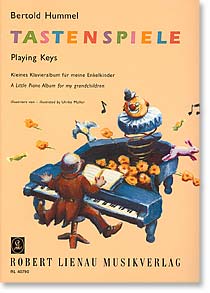Playing keys - A little piano album for my grandchildren, op. 103d (1996-2000)

1.
Semper idem
2.
Prelude
3.
Little Melody
4.
Desert Caravan
5.
Lullaby
6.
Chorale
7.
Scherzando
9.
Folk-song
10.
The Clown ![]()
11.
Finger Movements
12.
Serenade
13.
The Cuckoo
15.
Little March
16. Barcarole
Duration: 25 Minutes
Publisher: Robert Lienau Musikverlag Frankfurt RL 40790 / ISMN M-011-40790-5
| 1./2./3. | 8./10./11./15. | 9. Folk Song traditional |
Video: Works by Hummel on youtube
Press
Piano news April, 2002
The
"Tastenspiele" are a collection of 16 easy to medium-difficult
piano pieces written by the composer for his grandchildren. One is tempted to
speak of modern "Kinderszenen"; the pieces are appealing, varied,
musically sophisticated and suitable for introducing children but also adults
to contemporary sounds. The wonderful illustrations by Ulrike Müller make
the book a pleasure for the eye as well.
Belonging to the school of Hindemith
and Genzmer, he was already open in the 1950s to a "plurality of compositional
methods". Familiar with Gregorian chant from his childhood on, he increasingly
developed interest in modal procedures, going as far as dodecaphony - but he was
at the same time fascinated by tonal extensions such as polytonality or Messiaen's
sound colour theories and the rhythmical accomplishments of other cultures.
The composer of this book is then genuinely eclectic, has written music "suitable
for children" in a child-like spirit, but has produced a real firework of
colours and styles. A super book, an absolute "must" for all who have
children to give presents to or are still child-like themselves.
Üben & Musizieren 5/02
My
pupils were particularly attracted by the dedications.
Like detectives, they
put together theories and guesses about why the "The Clown"
should be especially "for Fabian", whether this whirling and insistent
"Scherzando" perhaps corresponds to the Josephine's character,
or whether Rafael ("Desert Caravan") maybe particularly
likes playing on the black keys, because each of the pieces in the Tastenspiele
by Bertold Hummel has in the dedication the name of one of his 16 grandchildren.
With this piano album, Bertold Hummel makes young pianists into jugglers: left
and right hand throw contrapuntal balls playfully back and fore or transport melodies
with hand-crossing into new regions and octaves. Independence and co-ordination
of the hands and fingers are stimulated by combinations of wide and close positions
and movements, by varied requirements of articulation and dynamics.
Hummel
always preserves the balance between complexity and simplicity, rhythmically or
melodically difficult phrases are carried on ostinato figures or become structural
building-blocks themselves. Easily grasped titles stimulate interpretations leading
to flights of imagination in the search for a corresponding realisation. The "Barcarole"
"for Julia" has to move in surging waves, the "cradle-song"
"for Charlotte" must rock peacefully, the "hectic party" "for
Viola" has to ring out audaciously, "Semper idem"
"for Anna" shows us the reserved constancy of an ostinato motif. Hummel
makes use of a broad palette of styles, from pentatonic to chromatic, from modality
to free tonality, from chorale setting to jazz patterns. With this variety of
compositional technique, including skilful use of intrusive factors (insertions
break the harmonic pattern and subdivide "Chorale" or
the seventh chords in a circle of falling fifths which transform and disguise
the simple melody of "Durchs Wiesetal gang i jetzt na" in "Folk-song"),
there is plenty of opportunity to talk with pupils about different compositional
principles. It is certainly worth-while taking pieces of this collection as models
and working on particular aspects. (Technical difficulty: upper elementary)
Maria Zeidler-Kröll
Revue Musicale Suisse / Schweizer Musikzeitung Nr. 4/2003
The author, who died a few months ago, dedicated these16 pieces expressly to his 16 grandchildren. As a result, not only are the levels of difficulty confined to upper first level and lower middle level, but also special consideration is given to the temperament and interpretative capacities of each recipient. This is the unique attraction of this collection. The most varied forms and styles are included, from folk-song to jazz rhythms and sounds, from simple homophony to free-tonal counterpoint, from uniform movement in eighth notes to the most quirky off-beat rhythms. Each piece is based on its own clearly formed musical or technical idea. In almost all pieces, however, a certain fundamental aim can be detected: to make a real experience out of the many aspects of piano sound, in the contrast of high and low, forte and piano, legato and staccato, the use of the pedal. This is underlined by the precise naming of the pieces (occasionally one might disagree, e.g. No. 3), challenging in various ways the awareness of the pupil. The book opens the way to numerous musical and technical experiences and provides, with its characteristic titles and the entertaining illustrations by Ulrike Müller, constantly new pleasure.
NMZ 10/02
Finger exercises,
a hectic party, clowning, and no timidity with "wrong notes": 16 easy
character pieces to perform, heart-warming souvenirs for a concert of the very
young, now published in Memoriam.
Ostfriesische
Nachrichten, 7th August, 2001
With the Children's Pieces by Bertold Hummel, refined and entertaining display pieces came into the programme.